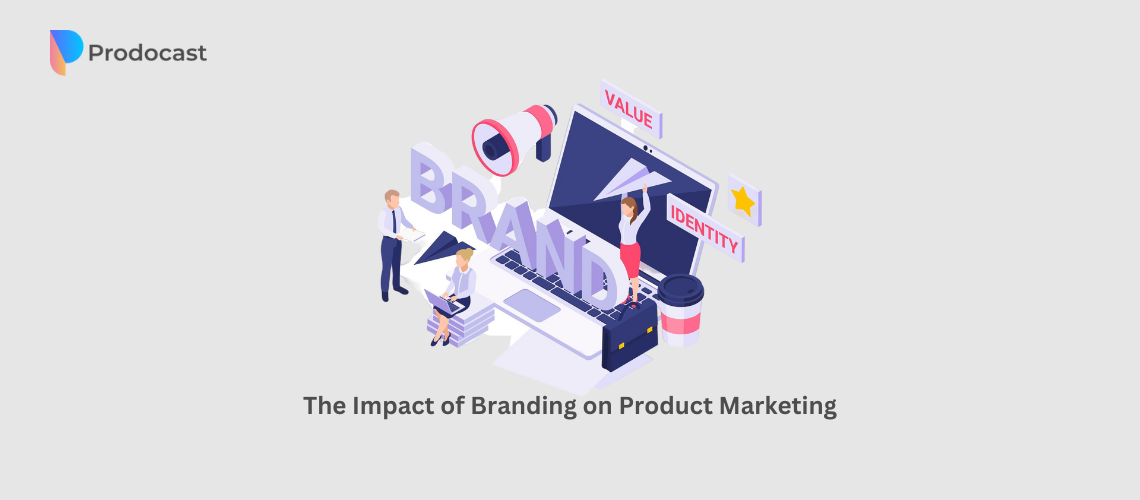Branding plays a pivotal role in the success of any product marketing strategy. In today’s highly competitive market, where consumers are overwhelmed with options, a strong brand identity can be the key differentiator that sets your product apart from the competition. This comprehensive guide explores how branding impacts product marketing and provides actionable strategies for building a strong, recognizable, and consistent brand identity.
1. Understanding the Importance of Branding
Defining Branding and Its Role in Product Marketing
Branding is more than just a logo or a catchy tagline. It is the entire perception of your product or company, influenced by various elements such as your mission, values, voice, design, and interactions with consumers. It is the sum of all experiences that customers have with your product or service, from their first awareness to post-purchase loyalty.
In product marketing, branding serves as a strategic tool that helps shape how consumers perceive and relate to your product. Branding is essential in product marketing because it:
- Establishes Recognition: Your brand helps your product stand out in the minds of consumers by creating a distinct and recognizable identity.
- Builds Trust: Consumers are more likely to engage with and purchase from brands they trust. A strong brand exudes reliability and credibility.
- Encourages Loyalty: Branding builds emotional connections that foster long-term loyalty. Customers who resonate with your brand are more likely to become repeat buyers and brand advocates.
In product marketing, branding impacts everything from the product’s value proposition to the overall customer experience, driving both short-term sales and long-term brand loyalty.
Benefits of a Strong Brand Identity
Building a strong brand identity offers numerous advantages that extend beyond the immediate sale of a product. Some of the key benefits include:
- Increased Customer Recognition: A strong brand identity makes your product easily recognizable, even in a crowded marketplace. When consumers see your logo, colors, or hear your brand’s name, they instantly associate it with your product’s unique qualities and benefits.
- Building Customer Trust: Trust is the currency of today’s business landscape. A well-established brand that delivers on its promises builds trust with customers. As a result, consumers are more likely to choose your product over a competitor, even if it’s priced higher.
- Price Premiums: Strong brands often command premium prices because they represent perceived value. Consumers are willing to pay more for a product that they believe aligns with their expectations of quality, trustworthiness, and emotional fulfillment.
- Emotional Connection: Successful brands evoke emotions. Whether it’s through storytelling, shared values, or lifestyle alignment, a strong brand identity connects with consumers on an emotional level, creating a deeper relationship that extends beyond transactional exchanges.
Branding as a Differentiator in Competitive Markets
In saturated markets, products often have similar features, benefits, and prices. What makes a consumer choose one product over another? The answer lies in the power of branding. Branding acts as a key differentiator that gives consumers a reason to choose your product. This is achieved through:
- Positioning Your Brand as Unique: A well-defined brand identity creates a narrative that highlights the unique aspects of your product—whether it’s innovative design, superior quality, or sustainability practices. This differentiation sets your product apart in the consumer’s mind.
- Creating Emotional Differentiation: Functional differences between products may be minimal, but emotional differentiation can be significant. Consumers make decisions based on how a brand makes them feel. By establishing a brand identity that resonates with a specific audience’s values or desires, your product can stand out even when competing products have similar features.
2. Building a Strong Brand Foundation
Building a strong brand identity starts with laying a solid foundation that reflects the core of your business. This process involves deep research, strategic development, and careful planning to ensure that your brand reflects your company’s mission and vision while resonating with your target audience.
Conducting Brand Research and Analysis
Brand research is the first step in creating a strong brand foundation. This involves gathering insights from various sources to ensure that your brand resonates with your target audience and stands out in the market. Key areas of research include:
- Market Research: Understand the competitive landscape by analyzing your competitors’ strengths and weaknesses, identifying industry trends, and studying customer behavior. This information helps you position your brand in a way that fills market gaps.
- Customer Insights: Conduct surveys, focus groups, and social listening to gather data on what your customers value most. Understanding their pain points, preferences, and buying behavior is critical to crafting a brand that resonates with them.
- Internal Stakeholder Input: Engage with internal teams such as sales, customer service, and product development to gather their perspectives on how the brand should be positioned. Their insights can provide valuable input on what differentiates your product and how to communicate it.
Developing a Clear Brand Mission, Vision, and Values
Once you’ve gathered research insights, the next step is to define your brand’s mission, vision, and values. These elements serve as the foundation of your brand identity and guide every marketing and communication effort.
- Brand Mission: The brand mission is the “why” behind your business. It should clearly articulate the purpose of your brand and the value it delivers to customers. A clear mission statement helps your brand stay focused and aligns all marketing efforts with your overall business objectives.
- Brand Vision: The vision statement outlines the long-term aspirations of your brand. It describes where you want to take your brand in the future, inspiring both your team and your audience.
- Brand Values: Your brand’s values define what you stand for and believe in. They shape how your brand interacts with customers, makes decisions, and positions itself in the market. For example, if your brand values sustainability, this should be reflected in your product development, packaging, and marketing efforts.
Creating a Unique Brand Personality and Voice
A brand personality gives life to your brand, making it relatable to your audience. It consists of the human-like characteristics that your brand exhibits in its communication and customer interactions. Some common brand personalities include:
- Friendly and Approachable: Brands like Coca-Cola use a friendly and welcoming tone to make consumers feel happy and included.
- Innovative and Cutting-Edge: Brands like Tesla project an image of innovation and forward-thinking, appealing to tech-savvy consumers looking for the latest advancements.
- Professional and Authoritative: Brands like IBM or Microsoft use a more formal and authoritative tone to convey expertise and trustworthiness.
Your brand voice reflects how you convey its personality. Whether through your website content, social media posts, or advertising campaigns, maintaining a consistent voice ensures that your brand remains easily recognizable and relatable.
3. The Role of Branding in Product Positioning
Product positioning is the process of placing your product in the mind of consumers in a way that clearly differentiates it from competitors. A strong brand identity is essential to product positioning, as it helps define how customers perceive your product in the market.
Understanding Target Audience and Their Needs
To effectively position your product, you need to have a deep understanding of your target audience’s needs, preferences, and challenges. This involves segmenting your audience into groups based on shared characteristics such as demographics, interests, and behavior. For each segment, consider the following:
- What are their pain points?
- What motivates them to make a purchase?
- What emotions are they seeking to fulfill with your product?
Answering these questions helps you tailor your brand messaging to address the specific needs of your target audience. It also allows you to position your product in a way that resonates with them on both a functional and emotional level.
Positioning the Product Based on Brand Identity
Once you have a clear understanding of your audience, you can position your product in alignment with your brand identity. This involves:
- Highlighting Unique Selling Points (USPs): Your product’s USPs should align with your brand’s values and promise. For example, if your brand promotes sustainability, one of your product’s USPs could be eco-friendly materials or ethical sourcing.
- Reinforcing Brand Values: The way you position your product should reflect the values that your brand stands for. If your brand emphasizes luxury, your product positioning should emphasize exclusivity, premium quality, and superior craftsmanship.
- Appealing to Emotions: Successful product positioning goes beyond functional benefits to tap into the emotions of your audience. Whether it’s the sense of accomplishment from using your product or the feeling of belonging to a community, emotional positioning can create a deeper connection with consumers.
Creating a Compelling Brand Story
A compelling brand story is an integral part of your product positioning. It provides context for why your brand exists and how it solves a particular problem for your customers. A brand story:
- Creates a Narrative: Your story should communicate the journey of your brand—how it started, the challenges you overcame, and your vision for the future.
- Connects Emotionally: A great brand story connects with consumers on an emotional level. Whether it’s through shared values or a common mission, your story should make consumers feel like they are part of your brand’s journey.
- Reinforces Brand Messaging: Your brand story should be woven into all aspects of your marketing, from your website copy to your advertising campaigns. Consistency in storytelling reinforces your brand’s message and keeps it top of mind for consumers.
4. Consistent Branding Across Channels
One of the biggest challenges in branding is maintaining consistency across all marketing channels. Whether a customer interacts with your brand on your website, through social media, or via email marketing, they should experience the same brand identity.
Ensuring Consistency Across All Marketing Channels
Consistency is crucial because it reinforces brand recognition and builds trust. When customers see consistent messaging, design, and tone across all touchpoints, it solidifies your brand’s image in their minds. Here’s how to achieve consistency:
- Website: Your website frequently serves as the initial interaction for prospective customers. Ensure that your brand’s design, messaging, and tone of voice are consistent with your overall brand identity.
- Social Media: Social media platforms offer opportunities to engage with your audience in real-time. While the tone may vary slightly depending on the platform (more formal on LinkedIn, more casual on Instagram), the core message should remain consistent.
- Email Marketing: Email campaigns are a great way to nurture leads and keep your audience informed about product updates or promotions. Ensure that the tone and design of your emails reflect your brand’s identity.
- Packaging: Packaging offers a physical representation of your brand. Whether a customer buys your product online or in-store, the packaging should reflect the same branding elements—logo, colors, messaging—that they’ve seen in other touchpoints.
Guidelines for Brand Style Guides
A brand style guide is an essential tool for maintaining brand consistency across all channels. It serves as a reference for anyone creating marketing materials, ensuring that the brand is always presented in a cohesive manner. A comprehensive brand style guide should include:
- Logo Usage: Guidelines for where and how the logo should be used, including minimum size, spacing, and acceptable variations.
- Color Palette: A well-defined palette of primary and secondary colors that symbolize your brand. This palette should be used consistently across all marketing materials.
- Typography: Guidelines for fonts and typefaces that are on-brand. Consistent use of typography creates a cohesive visual identity.
- Tone of Voice: A guide to the tone and language that should be used in all communications. Whether your brand is conversational, formal, or authoritative, maintaining a consistent tone helps reinforce your brand personality.
Maintaining Brand Integrity in Communications
Maintaining brand integrity means staying true to your brand’s values and promises in every customer interaction. Whether you’re engaging with customers through social media, email, or customer service, it’s important to:
- Be Authentic: Authenticity builds trust. Don’t try to be something you’re not, and avoid making promises you can’t keep. If your brand values transparency, be open and honest in all communications.
- Respond Consistently: Whether you’re responding to positive feedback or addressing customer complaints, ensure that your responses are aligned with your brand’s tone and values.
5. The Power of Brand Storytelling
Storytelling is a compelling method to humanize your brand and build an emotional bond with your audience. Great stories capture attention, evoke emotions, and make your brand more relatable.
Creating Engaging Brand Narratives
An engaging brand narrative goes beyond simply explaining what your product does—it tells the story of why it exists and how it solves a problem for your customers. Here are some key elements of a compelling brand narrative:
- Purpose: Explain why your brand exists and what problem it aims to solve. Consumers are more likely to connect with a brand that has a clear purpose beyond just making a profit.
- Challenges and Triumphs: Share the challenges your brand has faced and how you’ve overcome them. This creates a sense of authenticity and shows that your brand is resilient and adaptable.
- Vision for the Future: Your brand story should also include your vision for the future. Whether you’re working towards sustainability or innovation, sharing your goals makes consumers feel like they’re part of your journey.
Using Storytelling to Connect Emotionally
Emotional connections are the foundation of brand loyalty. By crafting stories that tap into the emotions of your audience, you can create a deeper relationship with your customers. Some strategies for emotional storytelling include:
- Highlighting Customer Success Stories: Share stories of how your product has positively impacted the lives of your customers. This not only builds trust but also reinforces the value of your product.
- Appealing to Aspirations: Show how your product helps customers achieve their goals, whether it’s improving their lifestyle, solving a problem, or fulfilling a desire.
- Addressing Pain Points: Share stories of how your brand has overcome challenges that your customers can relate to. This creates a sense of empathy and shows that you understand their struggles.
Incorporating Brand Stories into Marketing Campaigns
Brand storytelling should be integrated into all aspects of your marketing strategy. Whether it’s through advertising, social media, or content marketing, sharing your brand’s story helps reinforce your message and build a connection with your audience. Here are some ways to incorporate storytelling into your campaigns:
- Content Marketing: Use blog posts, videos, and case studies to tell your brand’s story. Share behind-the-scenes insights, customer testimonials, and the history of your brand to engage your audience.
- Social Media: Social media is a great platform for sharing bite-sized stories that highlight your brand’s values and mission. Use visual storytelling through photos, videos, and user-generated content to create an emotional connection with your followers.
- Advertising: Story-driven advertising campaigns are more memorable and engaging than product-focused ads. Use storytelling to create a narrative that resonates with your audience and showcases the value of your product.
6. Managing Brand Reputation
Your brand’s reputation is among its most valuable assets. In today’s digital age, where information spreads quickly, managing your brand’s online reputation is more important than ever.
Monitoring Online Brand Reputation
Monitoring your brand’s online reputation allows you to stay informed about what customers are saying about your brand. Here are some tools and tactics for tracking your online presence:
- Google Alerts: Set up Google Alerts for your brand name, product name, and key competitors. This tool will notify you whenever your brand is mentioned online.
- Social Media Listening Tools: Tools like Hootsuite, Sprout Social, and Brandwatch allow you to monitor conversations about your brand on social media platforms. This helps you stay on top of customer feedback and trends.
- Review Sites: Monitor review sites like Yelp, Google Reviews, and Trustpilot to see what customers are saying about your products. Positive reviews can be leveraged for marketing, while negative reviews should be addressed promptly.
Responding to Customer Feedback and Reviews
How you respond to customer feedback can significantly impact your brand’s reputation. Whether the feedback is positive or negative, it’s important to engage with your customers in a way that reflects your brand’s values. Here’s how to handle different types of feedback:
- Positive Feedback: Thank customers for their positive reviews and acknowledge their loyalty. Positive feedback is an opportunity to reinforce your brand’s value and create brand advocates.
- Negative Feedback: Address negative feedback promptly and professionally. Apologize for any issues and offer a solution. Effectively managing negative feedback can transform a dissatisfied customer into a loyal one.
- Neutral Feedback: Respond to neutral feedback with a personalized message, thanking the customer for their input and encouraging them to reach out with any future needs.
Crisis Management Strategies
A brand crisis can arise from a product failure, negative press, or a public relations mishap. Having a crisis management plan in place ensures that you can respond quickly and effectively to minimize damage to your brand’s reputation. Here’s how to manage a brand crisis:
- Acknowledge the Issue: Don’t ignore the problem. Acknowledge it openly and transparently, explaining what went wrong and how you plan to fix it.
- Take Action: Demonstrate that you are taking the issue seriously by outlining the steps you’re taking to resolve it. Whether it’s recalling a product or addressing a PR mishap, showing that you’re proactive can help rebuild trust.
- Communicate Consistently: Keep your audience updated throughout the process. Whether it’s through social media, email, or press releases, ensure that your messaging is consistent and aligned with your brand’s values.
7. Measuring Brand Equity
Brand equity refers to the value that your brand holds in the eyes of consumers. Measuring brand equity helps you understand how well your brand is performing and whether it’s resonating with your target audience.
Key Performance Indicators (KPIs) for Brand Measurement
There are several KPIs that can be used to measure brand equity, including:
- Brand Awareness: How well-known is your brand among your target audience? This can be measured through surveys, social media mentions, and website traffic.
- Customer Loyalty: Are customers choosing your brand over competitors? Repeat purchases, customer retention rates, and Net Promoter Score (NPS) are key indicators of customer loyalty.
- Perceived Quality: How do customers perceive the quality of your product compared to competitors? Perceived quality can be measured through customer surveys, reviews, and focus groups.
- Brand Associations: What attributes do customers associate with your brand? Positive associations like innovation, quality, or sustainability can enhance brand equity.
Using Brand Tracking Tools and Surveys
Brand tracking tools and surveys provide valuable insights into how your brand is perceived over time. Here are some tools you can use to measure brand equity:
- Brand Tracking Tools: Tools like YouGov BrandIndex and Kantar BrandZ allow you to track your brand’s performance against competitors and measure changes in brand awareness, loyalty, and perception.
- Customer Surveys: Conducting regular customer surveys can provide direct feedback on how your brand is perceived. Ask questions about brand recognition, product satisfaction, and brand associations to gauge brand equity.
Analyzing Brand Equity Over Time
Brand equity is not static; it evolves over time as your brand grows, competitors enter the market, and customer preferences change. Regularly analyzing your brand equity allows you to:
- Identify Strengths and Weaknesses: By tracking KPIs, you can identify areas where your brand is excelling and areas that need improvement.
- Adjust Marketing Strategies: If brand awareness is low or customer loyalty is declining, you can adjust your marketing strategies to address these challenges and strengthen your brand.
- Adapt to Market Changes: As the market landscape shifts, your brand may need to evolve to stay relevant. Analyzing brand equity helps you stay ahead of market trends and adapt your brand strategy accordingly.
Closing Thoughts
In conclusion, branding is an essential element of product marketing that can significantly impact the success of your product in the market. By building a strong brand identity, maintaining consistency across channels, leveraging storytelling, and managing your brand reputation, you can create a brand that resonates with your audience and drives long-term growth.
Bonus Tip: Promote Your Software on Prodocast
If you’re a software developer or vendor looking to expand your product’s reach, listing it on Prodocast is an excellent way to gain visibility. Prodocast allows you to list your software products for free, providing a platform to connect with potential customers and showcase your offerings to a wider audience. By leveraging digital channels and utilizing platforms like Prodocast, you can maximize your product marketing efforts and drive more traffic to your software.




